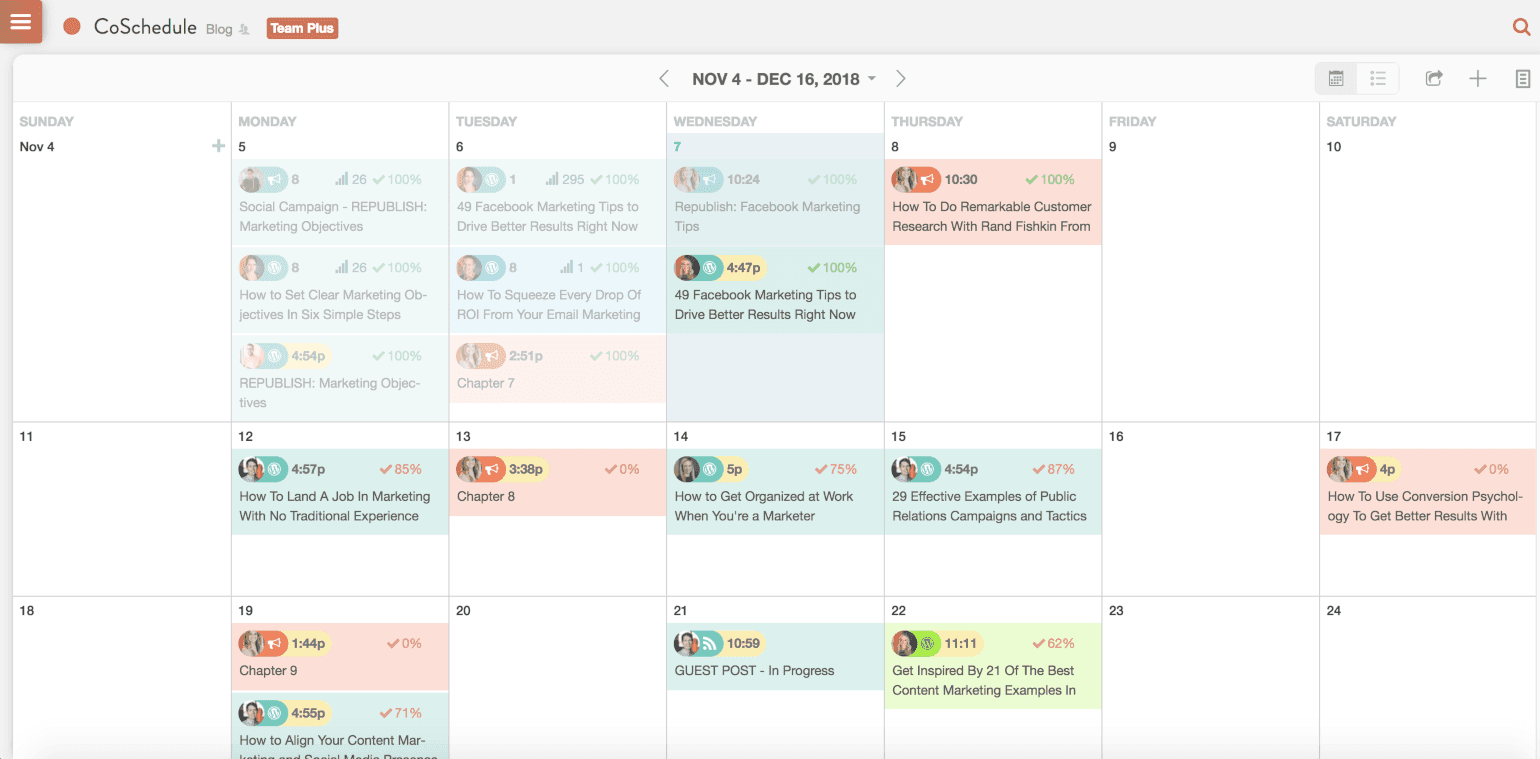You can’t make a bridge out of only rebar. You can’t build a house only with nails. A lot of different building materials and the knowledge of how to use them are required.
It’s not enough that you’ve already done the work to assemble a great marketing team.
Your team is made up of writers, editors, and some are great with SEO. Some people are just subject matter experts you need to extract the story from who know nothing about content marketing. Your team runs the gamut and without a concerted effort harness all of these different skills (and personalities) toward a common goal, you may end up with conflict.
Cross-functional teams have become more and more common in an age where speed has increased. The need to innovate and create at a faster pace means teams with a broad range of skills have to learn to work together. Gone are the days of large specific teams fussing forever on something before passing it off on to the next team and forgetting about it from that point on. In a cross-functional team, the entire ugly process happens in full view and cooperation of disparate team members.
When Cross-Functional Teams Go Dysfunctional
In a 2015 study, researchers found out that 75% of cross-functional teams weren’t actually all that functional. Lead researcher, Behnam Tabrizi found out that these teams were failing on several fronts:
- They couldn’t stay on budget.
- They couldn’t stay on schedule.
- They couldn’t stick to specifications.
- They couldn’t meet customer expectations.
They couldn’t stay aligned with a company’s goals.

Tabrizi noted that most of these teams were failing because of a specific (and seemingly obvious) reason: An organization lacks a systemic approach. He further explained it in terms of isolated “silos” where different team members (or groups of team members) didn’t work well together. The designers didn’t work well with the writers, for example, or the editors conflicted with the marketers.
When leadership doesn’t lead, when accountability doesn’t exist, when communication is foggy, and when goals aren’t clear and specific, cross-functional teams can’t perform.
Rest assured, even as we use the word leadership throughout this post, it’s you as the editor and marketer who is leading your business’ content efforts. You’re the one who has the power to pull together the team you need, even from multiple departments and walks of life, to grow your business.
Make Your Cross-Functional Team Actually Function
Clearly, you don’t want to be a part of that 75% of cross-functional teams running around in circles and never achieving their goals, but how do you avoid it? It seems inevitable that human nature will throw sand in the gears. That is when personality and communication conflicts will arise.
Create Layers From The Top Down
This may sound a little odd in an age where hierarchy in the workplace is gone. You must have leadership at the top that decides on complex decisions affecting these cross-functional team projects.
Tabrizi uses Cisco as an example, describing how they allowed 100 people to attend meetings, but only a core group of leaders could communicate back to them and tell them their functions. And, one level above this leadership was an even smaller team governing over them.
While you probably don’t have 120 people on your team, the idea is one that still has value for the small guy: Not everyone dictates to everyone else about what will happen. Only the leaders do. This may cause some strife in some teams, particularly in those where hierarchy is abandoned.
All opinions are valuable. There are times for having brainstorm sessions and problem-solving meetings. But sometimes, the leadership has to lead and the team must follow.
Focus On Roles
When you assembled your team you found people who had specific skills that were needed to get the job done. Wouldn’t it be smart to define the roles that those skills and specific people fill?
While you don’t want to create a “that’s not my job” culture in your cross-functional team, you do want to be specific about what you expect people to do, and deal with any troublesome ambiguity team members might feel.

One of the reasons some cross-functional teams get hung up is because someone is working outside of their role (often trying to be helpful) and that confuses the person who is supposed to do it. They decide it’s no longer their job and get in the habit of not doing it. Have meeting times for your team to brainstorm on the projects you all are working on. This will help each person know what role they are to play in finishing a task.
Have meeting times for your team to brainstorm on the projects that you all are working on. This will help each person know what role they are to play in finishing a task.
When you don’t clearly define a role, it’s difficult to use a task-based system to progress through the project. Your team members must know what is expected of them so they know when their task is complete.
One final note for leadership: If you give a team member a specific role, don’t micromanage and tell them how to do it. Let them do their work, or you’ll both kill motivation and create a sense of doubt.
Getting Approval And Marking Tasks Complete
Got a system where each team member can get approval to proceed along the path toward completion?
It’s funny how we forget about the need for details, such as defining what “done” means. By having a clear definition on what a completed task looks like, you give your team members the ability to make autonomous decisions.
This is a good thing. If they can’t do this, they have to run to leadership every step of the way.
For example, do your content marketers have a clear definition of what a post draft should look like? How about what an edited post should contain? And what about the final edits and voice your blog is going for?
As long as you are clear and specific, each team member can then “self-approve” and mark a task as complete. If, for some reason, you have tasks or roles that require leadership approval (e.g. purchases that fit within a budget), make that part of the definition.

As with roles, the more specific you get isn’t about being restrictive but is instead about providing more freedom. You give team members confidence because they know they are doing what is expected of them. This will also help with personal productivity for the whole team.
Working Efficiently And Quickly With Others
Working efficiently is a tough nut to crack.
We have a lot of posts on this blog about efficiency and productivity, but when you’re talking about a team instead of just an individual, it gets complicated.
Individual efficiency hacks are fine, but encourage your team members to use what works. Group efficiency is not based on a hack. It’s based on something very simple:deadlines.
Deadlines are not a fun concept for creative free spirits.
But deadlines must exist, and deadlines must matter. They must be enforceable and consequently enforced.
While you may not want to set a deadline for every tiny task (depending upon how detailed your tasks are), you are definitely going to want to set deadlines for major milestones. And, if your team habitually misses deadlines, you may, indeed, need to set them for smaller tasks. It really helps to learn how to meet deadlines as a team.
Lack of team efficiency is based on individuals not hitting deadlines. People miss deadlines because they’re overwhelmed.
- How many projects or tasks are on a team member’s plate?
- Are you burdening them with too many requests?
Maybe they’re unable to tell you they can’t get it all done. Missing deadlines is an indicator of exactly that.

- Does your team have the proper tools? You can hammer nails with a pipe wrench, but it’s going to take a long time. Does your team have the tools and resources they need to work quickly?
- Do they have the ability or expertise? You can tell a fish to be a bird, but it’s not gonna happen. Find a different role for this team member, find a way that they might fit in, or let them go.
- Are they confused about their role? Perhaps your team member is doing more than they are supposed to and that’s why they are missing deadlines. Revisit your roles and parameters and make sure your team members understand.
Remember that working quickly does not mean giving your team less time. You have to give them enough time to contribute, both in the actual work and in communicating with other team members (and you, the leader).
Leading Your Team
Leading a cross-functional team is difficult. Anyone in a position of leadership should determine whether or not they are using techniques to ensure success.
Defined Parameters
Did you clearly define the goals, the parameters, the budget, and the resources before your team got started? A cross-functional team is not the setting to be vague and touchy-feely. Be as specific as possible so your team knows the boundaries and the path. Every project (i.e. piece of content) should have defined parameters.
Periodic “Health” Checks
As a leader, do you have a system or habit in place where you can periodically check the progress of your team? It may be simply reviewing what tasks are completed, or having a mid-stream meeting with the team to see how things are progressing and holding team members accountable. If you don’t do these “health checks”, you are leaving project progress to chance, assuming every team member is going to perform properly.
Accountability
Do you have someone who oversees the entire process from start to finish? This isn’t about micromanaging and telling people how to do their job, but is simply about making sure that the work is progressing within specified parameters toward goals, budgets, and deadlines.

Proper Focus
Do you regularly retune your team’s focus toward project success? The team leader, while encouraging individual team members in their work, should always make project success the goal, not individual success.
Evaluate And Re-Evaluate Projects
Do you have a process to evaluate and re-evaluate projects? Not every idea is a great one, and it may be your project or content piece that needs to be scrapped instead of throwing good money (and time) after bad ideas. All projects should align with your big goal.
Evaluate And Re-Evaluate Parameters
You will have to readjust your parameters as your team changes. Work styles change, expertise changes, abilities change—do you have the ability or a system to keep on top of this? Do you regularly review how well your team is functioning and where the hiccups are coming from?
Keeping Sight Of The Goal
It’s easy to lose sight of the bigger picture, particularly when each team member has a small picture to focus on to get their job done. Without a frequent big-picture check, you and your team won’t stay on track to the common goal. You’ll get caught up in minutiae, disagreements, and so on.
Keeping In Mind
- How do you keep sight of the goal for each project or content piece?
- How do you make sure your team remembers the goals?
- Remember to set up periodic and systematic meetings meant for updates and team communication.
- Create posters and signs that define broad company or project goals.
- Email updates to the team.
- Message team members through boards, messages, or through CoSchedule comments.
Regular communication is the key, basically, whichever format works best with your team.
How CoSchedule Can Help Your Cross-Functional Team

One of the reasons we take a task-based approach to discussing cross-functional teams is because we use that approach for project management, and it works well. A task is simply a signifier of what needs to be done in what order. Once it’s checked as done, it’s a signifier to the next team member to start with their tasks.
Doing The Health Check
CoSchedule makes it easy for team leaders to view the progress of each piece of content and do those “health checks” without a lot of effort. The tasks for each project are easily accessed on the calendar, clearly showing what has been done and who completed it. Each content piece shows a task measurement bar that reveals, at a glance, progress based on the percentage complete.
Defining Project Parameters
By setting up a task template with due dates for each task for each member of your cross-functional team, you’re setting up parameters both in what needs to be done and when it needs to be done by.
Helping With Focus And Communication
With CoSchedule, each content piece has its own message board in the form of comments. Leaders and team members can easily communicate there to skip out on endless email forwards.
Controlling Team Access
By restricting the conversation to only those who are currently involved, team leaders can help out team members and keep them from being overloaded with messages and emails inside of CoSchedule.
Removing a team member who has completed their work on the project spares them from having to see conversations that don’t apply to them. It keeps them from getting into the habit of ignoring messages (meaning they’ll miss fewer messages intended for them in the future).
Using Notes And Color For Your Project Management System
Because CoSchedule is built on flexible features, including the ability to add notes and events to the calendar, you’re able to create a system that works for your team.
Perhaps you’ll schedule team meetings as an event on your content calendar or maybe the color-coded notes will indicate must-read memos for your entire team. It’s up to you to determine how you’ll use these flexible tools with your cross-functional team.
How Will You Lead Your Cross-Functional Team?
A healthy cross-functional team is one where diversity in skill is aligned toward the same goal. This requires purposeful leadership devoted to harnessing the power behind that diversity to the same wagon and driving it forward.
With cross-functional teams—clarity, specificity, and definition are all going to work for you, even if that sounds anathema to a culture that loathes hierarchy or restriction.

